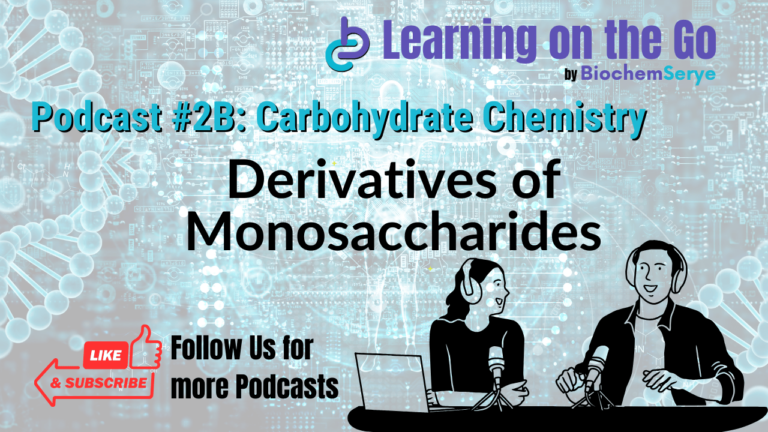Isomerism in Carbohydrates Biochemistry Notes
Isomerism in Carbohydrates Biochemistry Notes Outline
Isomerism in Carbohydrates Biochemistry Notes summarizes the different types of isomerism found in carbohydrates, as described in the provided text. Isomers are molecules with the same molecular formula but different structural arrangements. This difference in structure leads to varied properties and functions. The notes explicitly address five types of isomerism crucial to understanding carbohydrate chemistry.
Isomerism in Carbohydrates Key Themes and Concepts
General Definition of Isomerism
- Isomers are compounds that share the same molecular formula but differ in their structural arrangement.
- The phenomenon is called isomerism. The compounds possessing identical molecular formulas but different structures are called isomers. The phenomenon of the existence of isomers is called isomerism.
Types of Isomerism in Sugars
Five significant types of isomerism exhibited by sugars:
- Ketose-aldose isomerism
- D and L isomerism
- Optical isomerism
- Epimerism
- Anomerism
Ketose-Aldose Isomerism
- This isomerism is based on the difference in the functional group present in the molecule.

- Glucose (an aldose) and fructose (a ketose) are examples of this type of isomerism, having the same molecular formula (C6H12O6) but differing in the position of their carbonyl group. Glucose has an aldehyde group at carbon 1, while fructose has a keto group at carbon 2. There is a keto group in position two of fructose and an aldehyde group in position one of glucose.
D and L Isomerism
- This isomerism is based on the orientation of H and OH groups around the asymmetric carbon farthest from the carbonyl group (e.g., carbon 5 in glucose).

- When the OH group is on the right, it’s a D-isomer; on the left, it’s an L-isomer.
- D and L isomers are mirror images of each other (enantiomers). D and L isomers are mirror images of each other. These two forms are called enantiomers.
- Most monosaccharides in living beings are D-isomers. Most of the monosaccharides in living beings belong to the D-series.
Optical Isomerism
- The presence of asymmetric carbon atoms (carbon atoms with four different groups attached to it) causes optical activity in a molecule.
- Optical activity refers to the substance’s capacity to rotate plane-polarized light.
- Isomers can be dextrorotatory (d or +), rotating the light to the right, or levorotatory (l or -), rotating the light to the left.
- A mixture with equal amounts of d and l isomers is called a racemic mixture, which has no overall optical activity because the rotations cancel each other out. The resulting mixture has no optical activity when equal amounts of d and l isomers are present. Since the activity of each isomer cancels one another, such a mixture is said to be a racemic or dl mixture.
Epimerism
- Epimers are monosaccharides that differ in configuration around a single asymmetric carbon atom (excluding the anomeric carbon).

- Galactose and mannose are epimers of glucose, differing at carbon 4 and 2, respectively. When two monosaccharides differ from each other in their configuration around a single asymmetric carbon (other than anomeric carbon) atom, they are referred to as epimers of each other.
- Galactose and mannose are not epimers of each other because they differ in two asymmetric carbons.
Anomerism
- This type of isomerism arises when sugars cyclize, forming rings.

- In ring formation, a new asymmetric carbon is created at the carbonyl carbon (C-1 in glucose), also known as the anomeric carbon.
- Two forms of the sugar ring, known as anomers, are possible.
- The alpha (α) anomer has the hydroxyl (-OH) group at the anomeric carbon below the plane of the ring.
- The beta (β) anomer has the hydroxyl group above the plane of the ring.
- The designation a means that the hydroxyl group attached to C-1 is below the plane of the ring, β means that it is above the plane of the ring. The C-1 carbon is called the anomeric carbon atom, so α and β forms are anomers.
Isomerism in Carbohydrates Key Takeaways
- Isomerism is crucial to carbohydrate diversity and function. Different arrangements of atoms within the same molecular formula lead to molecules with different chemical properties and biological roles.
- Understanding the different types of isomerism (ketose-aldose, D/L, optical, epimerism, and anomerism) is fundamental to comprehending carbohydrate structure and behavior.
- The majority of monosaccharides in biological systems belong to the D-series.
- Ring formation in sugars gives rise to anomers, which have distinct properties in biological systems.
Isomerism in Carbohydrates Frequently Asked Questions
What is the fundamental concept of isomerism, and what does the term mean in the context of chemical compounds?
Isomerism refers to compounds that have the same molecular formula but different structural arrangements of atoms. The term “isomer” means “equal parts” in Greek.
Describe the key structural differences between a ketose and an aldose sugar, and give an example of each.
Ketose sugars have a ketone group, while aldose sugars have an aldehyde group. For example, fructose is a ketose, and glucose is an aldose.
What structural characteristic of a monosaccharide determines whether it is designated as D or L isomer?
The orientation of the hydroxyl (OH) group on the asymmetric carbon atom farthest from the carbonyl carbon determines if it is D or L.
Explain the concept of enantiomers, and describe the relationship between D and L isomers in this context.
Enantiomers are stereoisomers that are mirror images of each other. D and L isomers of a monosaccharide are enantiomers.
What does it mean for a substance to be optically active, and how is this property related to the structure of molecules?
Optical activity is the ability of a substance to rotate the plane of polarized light. It is due to the presence of asymmetric carbon atoms.
Explain the terms “dextrorotatory” and “levorotatory” in the context of optical isomers.
A dextrorotatory isomer (d or +) rotates plane-polarized light to the right, while a levorotatory isomer (l or -) rotates it to the left.
What is a racemic mixture, and why does it not exhibit optical activity?
A racemic mixture is an equal mixture of d and l isomers. Its optical activity is zero because the rotations caused by each isomer cancel each other out.
Define epimerism, and describe how epimers differ from each other structurally. Give an example.
Epimers are monosaccharides that differ in their configuration around a single asymmetric carbon atom, other than the anomeric carbon. Examples are galactose and mannose, which are epimers of glucose at carbon-4 and carbon-2, respectively.
What structural change occurs when a monosaccharide cyclizes in solution, and what is an anomeric carbon?
When a monosaccharide cyclizes, a new asymmetric carbon (anomeric carbon) is formed from the carbonyl carbon, leading to ring structures.
Distinguish between α and β anomers of glucose, and describe how these forms are structurally different.
In α anomers of glucose, the hydroxyl group at the anomeric carbon is below the plane of the ring, while in β anomers, it is above the plane of the ring.
Isomerism in Carbohydrates Glossary of Terms
- Isomer: Compounds that have the same molecular formula but different structural arrangements of atoms.
- Isomerism: The phenomenon of the existence of isomers.
- Ketose: A monosaccharide containing a ketone functional group.
- Aldose: A monosaccharide containing an aldehyde functional group.
- Asymmetric Carbon: A carbon atom that is bonded to four different atoms or groups.
- D and L Isomers: Stereoisomers that differ in the orientation of the H and OH groups around the asymmetric carbon atom farthest from the carbonyl group.
- Enantiomers: Stereoisomers that are mirror images of each other.
- Optical Activity: The capacity of a substance to rotate the plane of polarized light.
- Dextrorotatory: An optical isomer that rotates plane-polarized light to the right (designated as d or +).
- Levorotatory: An optical isomer that rotates plane-polarized light to the left (designated as l or -).
- Racemic Mixture: An equal mixture of d and l isomers, which shows no net optical activity.
- Plane Polarized Light: Light in which the vibrations of the electromagnetic field are confined to one plane.
- Epimers: Monosaccharides that differ in configuration around a single asymmetric carbon atom, excluding the anomeric carbon.
- Anomeric Carbon: The new asymmetric carbon formed upon ring closure from the carbonyl carbon in a monosaccharide.
- Anomers: Isomers of a monosaccharide that differ only in the configuration at the anomeric carbon, which can be either alpha (α) or beta (β).
- α-Anomer: A cyclic form of a monosaccharide where the hydroxyl group at the anomeric carbon is below the plane of the ring.
- β-Anomer: A cyclic form of a monosaccharide where the hydroxyl group at the anomeric carbon is above the plane of the ring.







